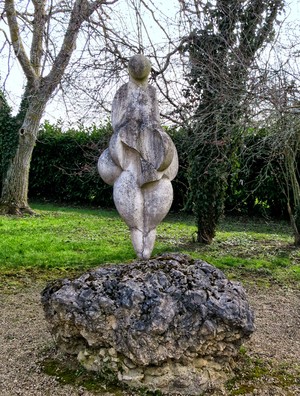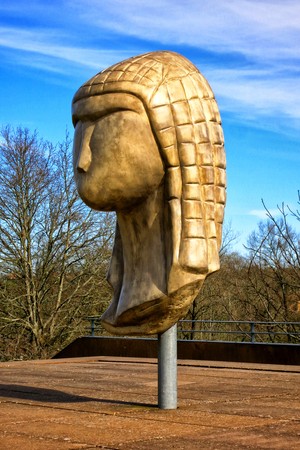Two Women – Then and Again


- SUBSCRIBE
- ALREADY SUBSCRIBED?
BECOME A BONJOUR PARIS MEMBER
Gain full access to our collection of over 5,000 articles and bring the City of Light into your life. Just 60 USD per year.
Find out why you should become a member here.
Sign in
Fill in your credentials below.
 I was reading a book called, “A Summer in Gascony“, by Martin Calder a few weeks ago and was surprised to learn that one of the oldest ivory statuettes ever found anywhere in the world was less than a 2 hour drive from my house. The Venus of Lespuges, dating from 33,000 BC, was discovered in 1922 by René and Suzanne St. Périer, in the Grottes des Rideaux, a cave in the gorges of the river Save, just below the tiny village of Lespuges, along the foothills of the Pyrenees in the department of the Haute Garonne. And, even though I also learned she no longer remained in Lespuges, nor resided in the Musée de Préhistoire in the nearby village of Aurignac, but was housed in the Musée de l’Homme in Paris, I decided to take a drive of discovery myself one Saturday morning along the old Salt Road linking the Atlantic to the Mediterranean since the Stone Age, my trusted Cadogan Guide to Gascony and map of the Midi-Pyrenees with me.
I was reading a book called, “A Summer in Gascony“, by Martin Calder a few weeks ago and was surprised to learn that one of the oldest ivory statuettes ever found anywhere in the world was less than a 2 hour drive from my house. The Venus of Lespuges, dating from 33,000 BC, was discovered in 1922 by René and Suzanne St. Périer, in the Grottes des Rideaux, a cave in the gorges of the river Save, just below the tiny village of Lespuges, along the foothills of the Pyrenees in the department of the Haute Garonne. And, even though I also learned she no longer remained in Lespuges, nor resided in the Musée de Préhistoire in the nearby village of Aurignac, but was housed in the Musée de l’Homme in Paris, I decided to take a drive of discovery myself one Saturday morning along the old Salt Road linking the Atlantic to the Mediterranean since the Stone Age, my trusted Cadogan Guide to Gascony and map of the Midi-Pyrenees with me.
After a leisurely drive I veered southeast of the village of Boulogne-sur-Gesse and quickly spotted 2 historical signs indicating the village of Lespuges and the Grottes des Rideaux. Climbing high along a narrow, serpentine switchback road I reached a small parking lot across from a rusted blue, historical sign that read, Ruins du Chateau de Lespuges. I parked my car and walked through the remains of a 14th century oak grove through inches of thick mud from recent storms to where the Chateau de Lespuges hung precariously off a cliff above the gorges. I took a photograph, then continued walking a short distance to the center of Lespuges, but found everything closed, including the museum. Granted, it was almost lunchtime, when everything closes in the southwest for the midday meal, but there was nothing heralding one of the greatest discoveries ever found from the Paleolithic era, except a huge concrete reconstruction of the statuette, which in reality is a mere 6 inches tall, in a little park I almost missed stopping at.
 Thoroughly disappointed, I walked back to the car and pulled out my Cadogan guide hoping to find another prehistoric site which I did, in the village of Brassempouy, only it was further west than where I began in the morning. I bought a salad from a corner take-out restaurant in the village of Boulogne-sur-Gesse and ate it in the cemetery parking lot overlooking the valley below. After a quick walk through the cemetery which, had one of the most amazing religious assemblage statues I’ve ever seen, I left for the journey back from whence I came.
Thoroughly disappointed, I walked back to the car and pulled out my Cadogan guide hoping to find another prehistoric site which I did, in the village of Brassempouy, only it was further west than where I began in the morning. I bought a salad from a corner take-out restaurant in the village of Boulogne-sur-Gesse and ate it in the cemetery parking lot overlooking the valley below. After a quick walk through the cemetery which, had one of the most amazing religious assemblage statues I’ve ever seen, I left for the journey back from whence I came.
 The lush region of the Chalosse, located in the second largest department in France, (the Landes) is home to the earliest known realistic representation of a woman, the Venus of Brassempouy. The village of Brassempouy is situated south of Mont de Marsan, in between the fertile valleys of the Adour and Pau rivers. This strikingly beautiful piece of mammoth ivory statuette is less than 2 inches tall. She is also known as the Dame a la Capouche, (Lady with a Hood), for her highly stylized corn row headpiece, which is either a depiction of hair or a fabric head covering.
The lush region of the Chalosse, located in the second largest department in France, (the Landes) is home to the earliest known realistic representation of a woman, the Venus of Brassempouy. The village of Brassempouy is situated south of Mont de Marsan, in between the fertile valleys of the Adour and Pau rivers. This strikingly beautiful piece of mammoth ivory statuette is less than 2 inches tall. She is also known as the Dame a la Capouche, (Lady with a Hood), for her highly stylized corn row headpiece, which is either a depiction of hair or a fabric head covering.
The very first French, Upper Paleolithic sites were just being excavated at the end of the 19th century outside of the village of Brassempouy. They were the Galerie des Hyènes (Gallery of Hyenas) and the Grotte du Pape (Cave of the Pope). Since archeological excavation techniques were relatively new, scant attention was paid to the destruction, almost beyond reconstruction, of the Grotte du Pape site by a group of amateurs representing the Association Française Pour l’Avancement de la Science in 1892, until Édouard Piette arrive in 1894. He discovered the Venus of Brassempouy statuette fragment in extensive layers of ivory found inside the cave along with 8 other figures. The Brassempouy Venus carbon dates to 25,000 BC. Because ivory is easily damaged by light, moisture and temperature, she is exhibited in the Salle Piette of the Musée d’Archéologie Nationale at Saint Germain-en-Laye near Paris, by appointment only. In the village of Brassempouy itself, other regional archeological objects are on view at the Maison de la Dame, a small, partially underground museum. Casts and specimens devoted to illustrating the importance of prehistoric Venus figurines are on display and the dig sites themselves can be visited during the summer months.
 The last thing I did before I turning back home was to climb the rickety old stairs to the top of the bell tower of the Church of St. Sernin. I could see storm clouds gathering around the Pic du Midi du Bigorre. I thought about the people who created the first art as the vestiges of the last European Ice Age were receding. Who were they? What was their culture like? Were the Venus of Lespuges and the Venus of Brassempouy fertility goddesses or good luck charms, or were they nature spirits from whom all else flows? Seen through 21st century eyes there seem to be no answers, only more questions. Their sculptures were telling a story we have yet to decipher and may never.
The last thing I did before I turning back home was to climb the rickety old stairs to the top of the bell tower of the Church of St. Sernin. I could see storm clouds gathering around the Pic du Midi du Bigorre. I thought about the people who created the first art as the vestiges of the last European Ice Age were receding. Who were they? What was their culture like? Were the Venus of Lespuges and the Venus of Brassempouy fertility goddesses or good luck charms, or were they nature spirits from whom all else flows? Seen through 21st century eyes there seem to be no answers, only more questions. Their sculptures were telling a story we have yet to decipher and may never.
More in Gascony, Lespuges, statue


